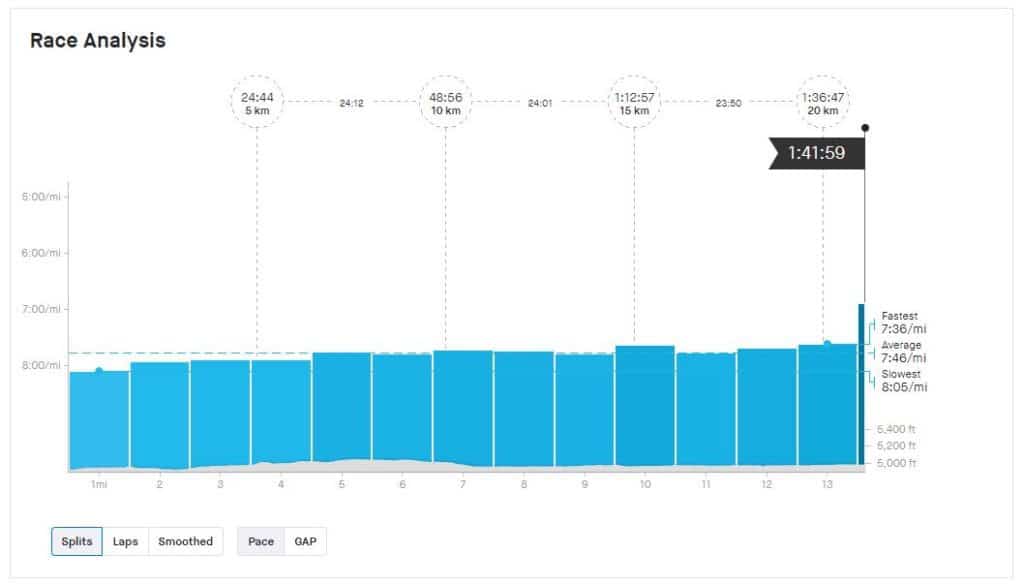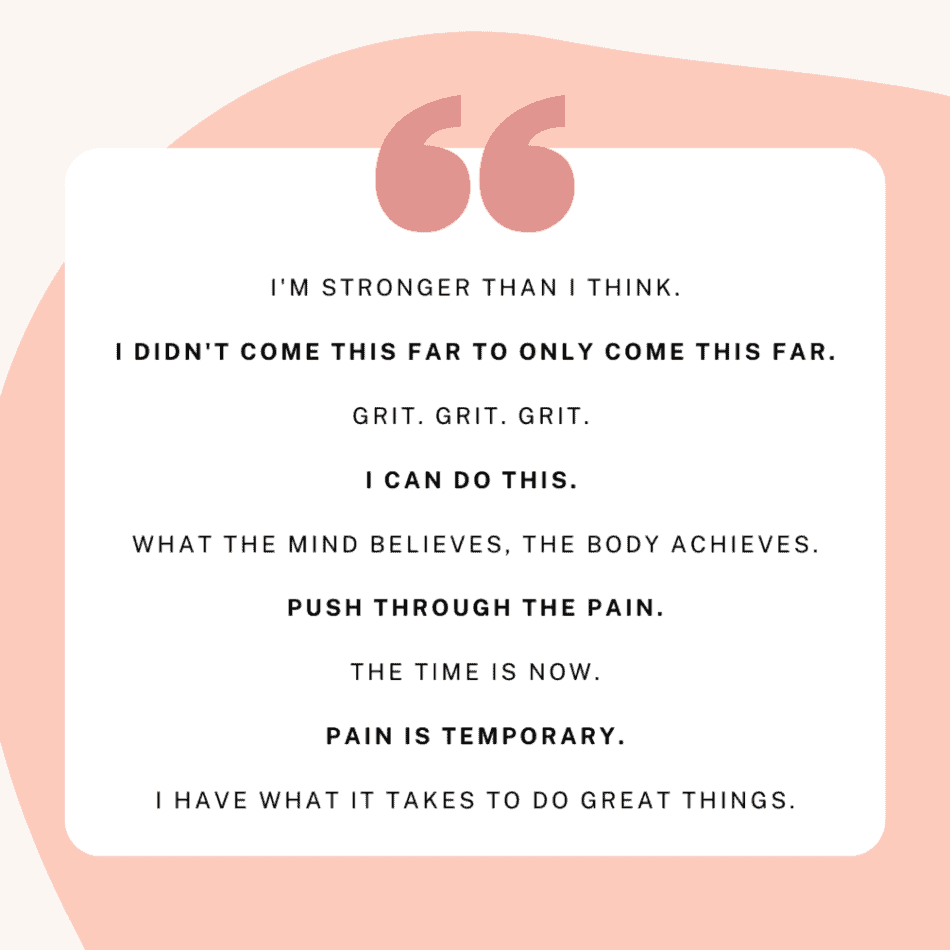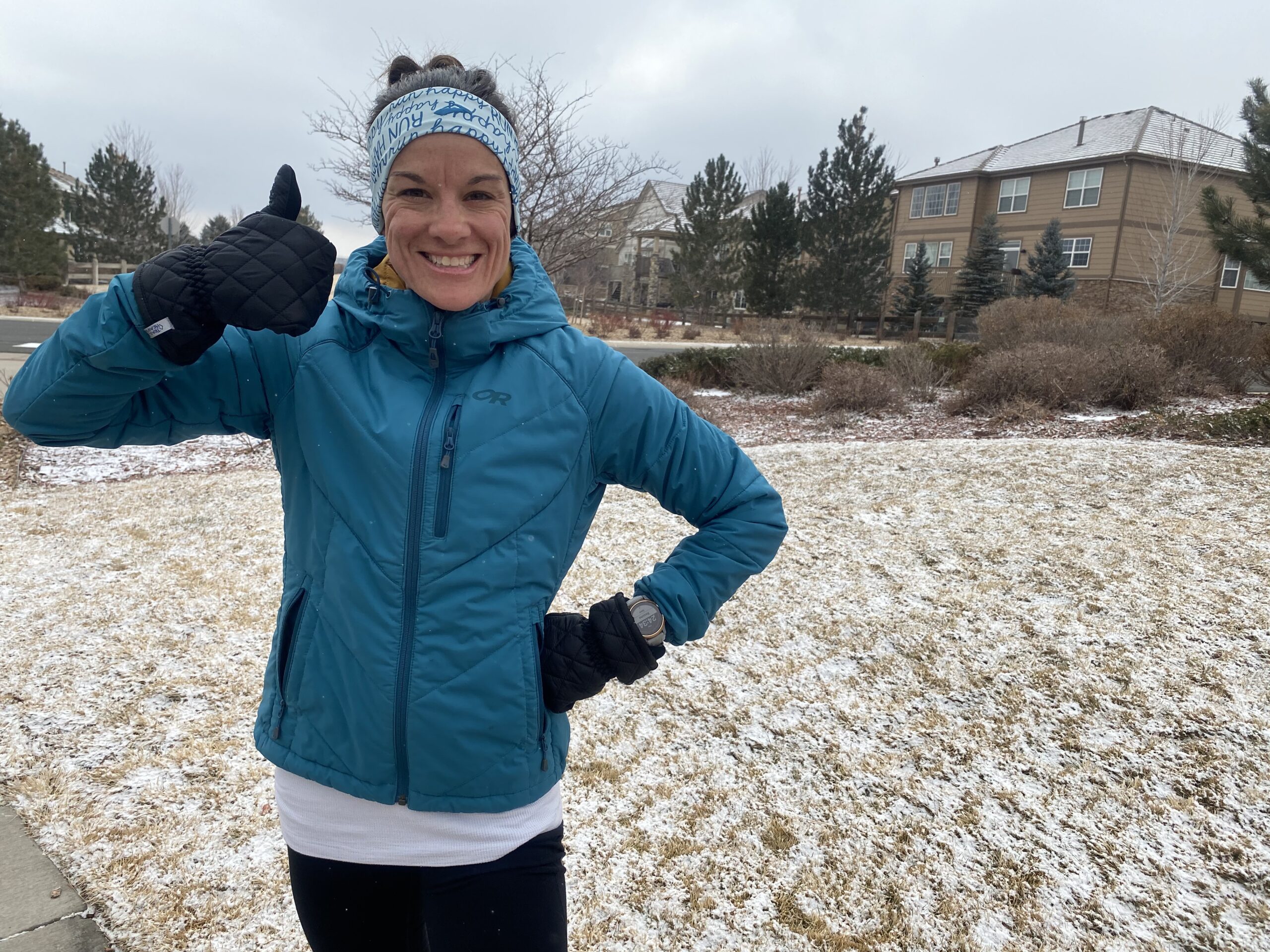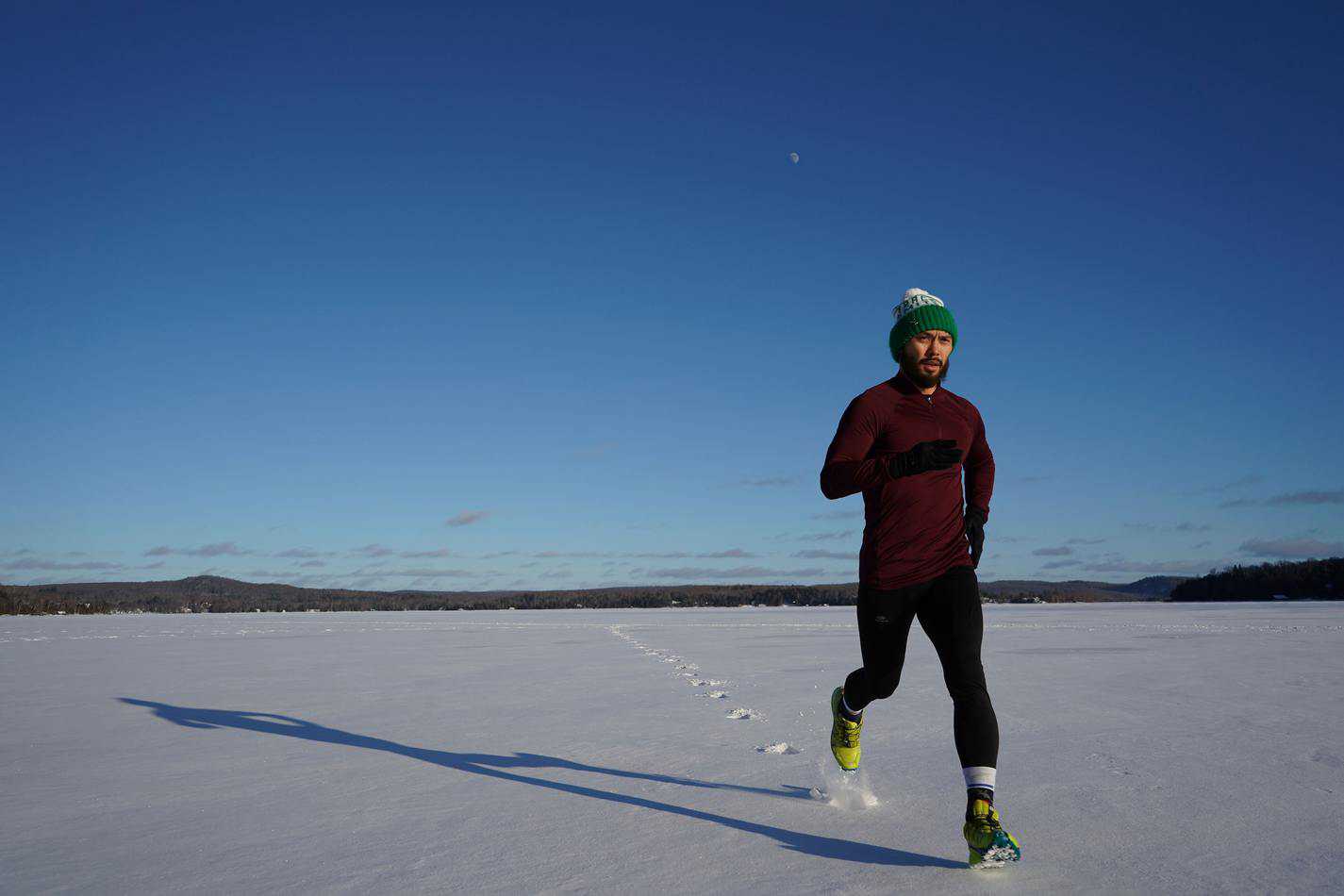No matter how many shorter races you’ve run or how pro you’ve become at pacing those, it just doesn’t carry over the same way to a marathon. Pacing a marathon takes a lot of practice in training and trusting yourself enough to put it into play on race day.
In hopes of helping you pace your marathon as well as possible, I’ve put together the top tips I’ve learned through my marathon journey. You’ll find that there’s a lot to it, but nobody ever said the marathon was easy – pacing being one of the parts that can be tough to nail down. But if you start utilizing these strategies early in your marathon training and allow yourself to let your ego go on race day, I know you can pace that marathon exactly as you pictured it in your mind.
Read on to find out how to pace a marathon!
Top 10 Tips for How to Pace a Marathon
Don’t wait until the day before your race to start thinking about how you’re going to pace your marathon. In order to understand marathon pacing, you want to consider it as soon as you begin your marathon training.
Pre-Race Day: Learn to Pace in Training
Understanding your marathon goal pace and learning how to pace in training is key to putting all the pieces together come race day. So, let’s start with those tips first.
Tip 1: Know Your Predicted Marathon Pace
When I say “know your predicted marathon pace” that doesn’t mean guess! With all the race predictors available these days, there is really no reason to go into marathon training completely blind to what a reasonable marathon pace and finishing time would be for you. This is doable even if you’ve never run a marathon.
The best way to figure out your predicted marathon pace is to use a recent race time such as 5k or 10k race. Ideally, it would be a time you earned within a few months of the start of your marathon training. If you don’t have that, a time trial works really well for determining a predicted marathon finish time.
This video from my YouTube channel as well as this blog post will tell you exactly what you need to get this figured out. Essentially, you’ll put your recent race time or two-mile time trial finish time into the McMillan Calculator (or similar) and it will tell you what your predicted marathon finish time will be (assuming you train properly) along with what per mile pace that equates to.
Example: 2-mile time trial of 16 minutes equates to a 4:14 marathon or a 9:43 pace.
You now have your marathon goal pace and you can start getting used to this pace during your training.
Tip 2: Sprinkle Marathon Pace Into Your Training
So now that you have your marathon goal pace, does this mean you should always train at this pace? Not at all! Many novice marathoners think they are supposed to run all of their long runs at their goal marathon pace, but that’s just not how it’s done.
If you try to run all of your long runs at marathon pace, you will likely get injured or will not be able to complete the rest of your mileage during the week that will be required of you to train properly. For more on this, read Train Slower to Run a Faster Marathon.
Your long runs should generally be run about 60-90 seconds slower than your marathon pace. (Which is another good reason to know your marathon goal pace.)
With that said, you DO need to practice your marathon pace. This can be achieved by including marathon pace miles into your long run (or another pace/speedwork session during the week).
Here are a few ways to practice marathon pace without overdoing it:
- On a 16-mile long run (as an example), do a 2-mile warm-up and then move into 3 x 2 miles at marathon pace with 5 minutes of recovery running in between. Then run your easy long run pace until you’re finished. Towards the end of your training (but before the taper) try 4 x 2 miles or 3 x 3 miles.
- Do a “fast finish” long run that includes marathon pace for the last 20-30 minutes. This can be challenging, so you may want to try it first on a long-run distance you’ve done before.
- Include 6 miles of steady-state running at your marathon pace in your long run or medium-long run.
Tip 3: Practice Negative Splits During Training Runs
Running negative splits means you run the second half of a race or run faster than the first half.
Here is a good example of negative splits from my last half marathon:

Though slight, you can see that the first four miles of my race were the slowest, and then I progressively got faster as the race went on.
In order to achieve negative splits on race day, you need to practice it in your training. The easiest way to do this is to always make it a point to ease into your runs. Whether it’s a recovery run, a long run or even a speed session, be really conservative at the start. Which is honestly better for your body anyway by giving it time to warm up.
Now this doesn’t mean skip the cool down period, but just by aiming for the majority of your later miles to be faster than your first ones will help your body get used to finishing faster than your started.
Tip 4: Research Your Course
You might think that all marathons are created equal, but they’re not. The amount of elevation involved in the marathon makes a big difference in how challenging the course will be.
Let’s use these three races as examples:
- Tunnel Marathons – 2,000 feet of elevation loss
- Berlin Marathon – 179 feet of elevation gain
- San Francisco Marathon – 1,711 feet of elevation gain
Even if a race starts and ends at the same spot, the amount of elevation gain within the course (aka HILLS) makes a difference. Running more hills will exhaust you more than a course that’s as flat as a pancake. There is a reason Eliud Kipchoge broke the world record on the Berlin course…not too much downhill, or uphill…just right.
What does this have to do with pacing? Knowing where the hills are, as well as knowing how much elevation change there is within a course, will help you know if you may need to start more conservatively (a hilly course) or if you may be able to pick up the pace (downhill course). And if you ARE running a course with a lot of elevation such as the one in San Francisco, you’ll likely need to adjust your goal marathon pace ahead of time to account for the extra effort.
Case in point: My husband and I ran a half-marathon in 2013 and thought we had our goal pace all figured out…come to find out the race had over 1,000 feet of elevation gain over those 13.1 miles. I felt disappointed after when I was off the mark, but had I researched the course, I could have adjusted my expectations a bit as well as paced myself better.
Still deciding on which marathon to run? Check out my article The best Marathon in Each State to get some ideas!
Race Day: Pacing Strategy for Your Best Marathon
When you get to the start line of your marathon, you should already have a set plan for how you’re going to tackle your pacing strategy. Now that you’ve (hopefully) trained appropriately to pace it well, it’s time to put everything into action. Let’s continue on to find out what you need to do (read on or watch my YouTube video for the top tips!)
Tip 5: Don’t “Bank Time”
Runners get so nervous about not being able to hit their goal marathon pace at the end of their marathon that they think they should “bank time” at the beginning by going faster than their goal marathon pace. But this will sabotage your marathon and cause you to hit a wall way too early in your marathon. Because this is so common, I wrote an entire article about this.
This will cause you to go slower overall in your marathon, NOT faster. And will likely mean you’re in a world of hurt as you slog through those last 6-8 miles.
According to this article from Fellrnr, running “the first mile significantly faster than the average race pace causes a disproportionate slow down towards the end.” Even just running 10-15 seconds per mile faster than your goal marathon pace (or the pace you are trained for) will hurt your marathon, not help it.
Go out too fast and you will pay for it.
Do not convince yourself otherwise. Period.
Tip 6: Start Out Slower Than Marathon Pace
Novice marathoners often tend to go out too fast, but even running those first miles at your predicted marathon goal pace can backfire. The solution? Plan to run the first 5k at a slower pace than your predicted marathon pace. Here’s why it’s better to do this:
- You’ll give your body time to warm up. Your body may have warmed up walking to the start line or by jogging a bit and stretching beforehand, but your body is going to need time to adjust as you get into your marathon pace groove. Backing off will let your body acclimate appropriately without causing your heart rate to spike.
- You can take note of how your pacing feels. Even though you’re likely ready for your predicted marathon pace, you may quickly find that it’s too much. By going a bit slower during the first 5k, you’ll be able to gauge how it feels and ensure you don’t overdo it.
- You’ll be able to go faster at the end. It’s been proven that runners who go out too fast will hit a wall much sooner in the race and in turn end up with a SLOWER marathon time, not a faster one (more on that next). Going slower than your marathon goal pace, in the beginning, will actually allow you to end up with a better race time. I promise! It’s a marathon, y’all, not a 5k…and you’ll have plenty of time to make up the time late in the race if you’re feeling good.
- You won’t have to stress out about getting around the slower runners around you. Seriously, don’t exert extra energy and add on distance by trying to weave around other runners. If they’re slowing you down during the crowded first mile, go ahead and think of that as a good thing! Weird, I know, but it’s true.
Be the smart one at the starting line, and ease into your race.
You’ll perform better and enjoy the race a whole lot more.
Tip 7: Aim for Even Effort, NOT Even Pace
It’s great to keep an eye on your pace, but you really need to listen to your body, too, and pay attention to the effort you’re putting forth. It’s best to use a pacing strategy that focuses on keeping the EFFORT even through the majority of the race as opposed to keeping an even pace.
So, instead of running every single mile at a 9:00/mile pace (if you’re shooting for a 3:56 marathon), it’s much better to pace your miles by keeping your effort roughly the same. This means your downhill miles will be a bit faster than 9:00/mile, your flat miles very close to that pace, and your uphill miles a bit slower than 9-minute miles. This ensures you don’t overexert yourself on the uphill portions.
That’s why I love using the data you can get at Find My Marathon. They sell pace bands that can be really helpful, but you can also just get the data you need to plan accordingly by plugging in some info.
Here’s what an even effort pace strategy would look like for that hilly San Francisco Marathon:

Find My Marathon already did the tough work for you by figuring out where the hilliest miles are and what pace is ideal to keep an even effort (yet still meet your goal time). The fastest pace for an even effort happens at mile-15 because it has the most downhill, whereas miles 6, 9 and 13 are run at a pace more than 30 seconds/mile slower than goal pace because there is a lot of uphill.
And if you don’t know where the hills will be ahead of time? That’s ok! Just slow down a bit when you come to a hill, speed up a bit on a downhill, and run by feel.
This type of pacing makes so much sense, so when you’re on those hills, you need to be okay with the fact that you’re not quite on pace. Go slower, make it up on the downhill, and you’ll have a lot more to give at the end!
Tip 8: Run Your Own Race
A big part of the reason so many newer runners (and even experienced ones at times) struggle to start conservatively is due to getting caught up in the excitement of the crowd. Though it’s definitely okay to get excited and have that adrenaline rush, you need to hold onto it until later. Just because everyone else around you is going out fast, doesn’t mean that you should. Don’t pay attention to what everyone else is doing.
In my last half marathon, I ended up passing so many runners in the last few miles because I paced conservatively at the beginning. (While still giving me plenty of time to achieve my goal.) Had I tried to stick with them, my race would have suffered and I would have slowed down right alongside them.
Additionally, it can be tempting to stay on track with a friend who is running the race, too. But chances are that you have different abilities and different goals. So unless you are both truly going for the same pace, it’s better to give hugs and high fives at the start line and then see them at the finish line.
Tip 9: Turn Off the Negative Voice Inside Your Head
No matter how great of a runner you are, self-doubt will likely creep in as you start to enter the pain cave that the marathon puts you in later in the race. For example, I haven’t walked in a race in the last decade – whether that was a 5k or a marathon, yet, I still get this voice inside my head later in races when it really starts to hurt and my brain starts to tell my body that I can’t run one step further.
Your brain is LYING to you.
Your pace will fall off quickly if you let negative thoughts creep in. You will try to convince yourself to slow down, when a lot of the time, you can keep it up to the finish line. This is where it’s a good time to put your mantras that you’ve practice during training into place. Saying things to yourself like the following will help a lot more than you would think!
Here are a few of my favorite marathon mantras:

(Also, I am not saying at all that walking in a marathon is bad. Some people, like those who use the Run/Walk method described here, even train this way. I’m just saying your body can handle more than you think it can and you have to believe that to make it happen.)
Tip 10: Push Those Last Miles as Hard As You Can
Not going to sugarcoat it – those last miles of a marathon hurt. In fact, it’s likely not your lack of endurance that’s getting in the way at the point, but the fatigue your legs are feelings.
Once you have gotten to those last 3-6 miles in a race, it’s time to leave everything out there. You may be right on track with your pacing, but you also may notice that it’s incredibly hard to hang onto. My biggest advice at this point is to just run the mile that you’re in and not worry about the ones coming next. Try to focus on hitting your pace in that mile only, and you can worry about the next one when it comes. Hold onto that pace for as long as you possibly can and once you’re down to the last two miles give it all you’ve got…when that finish line comes you’ll be so happy that you did.
Evaluating Your Pace After the Race
No matter what happens in your marathon, you can’t go back and make the outcome any different. Hopefully, you rock your predicted race pace and end up happy with the way it turned out, but if it didn’t go as planned you should still be incredibly proud of your effort. But it’s always good to analyze a race after the fact to pinpoint where things went well and think about what you can do better the next go around.
Your pacing will improve as you race more.
Running more marathons helps you better understand how to pace. The article “Slow Starts, Fast Finishes” writes, “Over 65% of first-timers go out too fast, but less than 20% of those on their second marathon are fast-starters and fast-starters all but disappear as the number of marathons increases.” So if the pacing doesn’t quite go your way on your first marathon, use that knowledge to your advantage on the next one.








